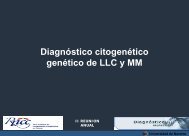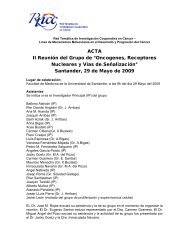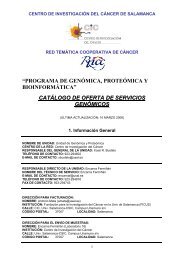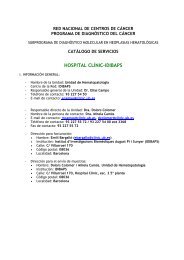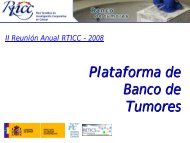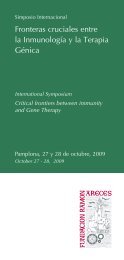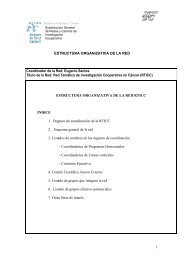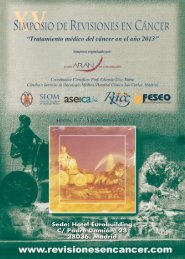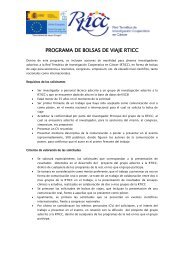Untitled - Red Temática de investigación cooperativa en cáncer
Untitled - Red Temática de investigación cooperativa en cáncer
Untitled - Red Temática de investigación cooperativa en cáncer
You also want an ePaper? Increase the reach of your titles
YUMPU automatically turns print PDFs into web optimized ePapers that Google loves.
O-16<br />
ETV5 AND FOXM1 TRANSCRIPTION FACTORS ARE OVEREXPRESSED IN<br />
OVARIAN CANCER AND REGULATE CELLULAR ADHESION AND PROLIFE-<br />
RATION CONTRIBUTING TO TUMOR DISSEMINATION<br />
LLAURADÓ M 1 , MAJEM B 2 , CASTELLVÍ J 2 , CABRERA S 3 , PÉREZ-BENAVENTE A 3 , COLÁS E 1 , RIGAU<br />
M 1 , OLIVÁN M 1 , DOLL A 1 , ABAL M 1 , DOLCET X 4 , MATÍAS-GUIU X 4 , GIL-MORENO A 3 , XERCAVINS<br />
J 3 , RUIZ A 1 , REVENTÓS J 1<br />
O-17<br />
COUNTERACTING AUTOPHAGY OVERCOMES RESISTANCE TO EVEROLI-<br />
MUS IN MANTLE CELL LYMPHOMA<br />
ROSICH L 1 , XARGAY-TORRENT S 1 , G. LÓPEZ-GUERRA M 1 , CAMPO E 2 , COLOMER D 1 , ROUE G 1<br />
1<br />
HOSPITAL CLÍNIC–IDIBAPS, BARCELONA (RD06/0020/0014)<br />
2<br />
HOSPITAL CLÍNIC–IDIBAPS, BARCELONA (RD06/0020/0039)<br />
1<br />
INSTITUT RECERCA VALL HEBRÓN, BARCELONA (RD06/0020/0058)<br />
2<br />
PATOLOGÍA HOSPITAL VALL HEBRÓN, BARCELONA (RD06/0020/0058)<br />
3<br />
GINECOLOGÍA HOSPITAL VALL HEBRÓN BARCELONA (RD06/0020/0058)<br />
4<br />
IRB LLEIDA (RD06/0020/1034)<br />
Background and aims: Epithelial ovarian cancer is the most lethal gynecological malignancy<br />
and the fifth leading cause of cancer <strong>de</strong>aths in wom<strong>en</strong> in the Western world. ETS transcription<br />
factors are known to act as positive or negative regulators of the expression of g<strong>en</strong>es that are<br />
involved in various biological processes. We have characterized the upregulation of the ETV5<br />
g<strong>en</strong>e (an ETS transcription factor) in <strong>en</strong>dometrial cancer (Monge M 2005, 2007, 2009; Planagumà<br />
J 2011; Colás E 2012). In the pres<strong>en</strong>t study we have investigated the role of ETV5 in epithelial<br />
ovarian cancer.<br />
Methods: We analyzed ETV5 expression by quantitative RT-PCR and immunohistochemistry in<br />
ovarian tumor samples and controls. We examined the biological effects of modulating ETV5<br />
expression in two differ<strong>en</strong>t human ovarian cancer cell lines. We analyzed cell adhesion proteins<br />
by using immunofluoresc<strong>en</strong>ce and Western blot, and we performed proliferation, migration, adhesion<br />
and apoptosis assays. Moreover, we analyzed by g<strong>en</strong>e expression microarray technology<br />
those g<strong>en</strong>es whose expression was altered in an ovarian cancer cell line with a stable downregulation<br />
of ETV5.<br />
Results: We found ETV5 upregulated in ovarian tumor samples compared to ovarian tissue<br />
controls. The in vitro inhibition of ETV5 <strong>de</strong>creased cell proliferation in serum-<strong>de</strong>prived conditions,<br />
induced EMT and <strong>de</strong>creased cell adhesion to extracellular matrix compon<strong>en</strong>ts. ETV5 inhibition<br />
also <strong>de</strong>creased cell-cell adhesion and induced apoptosis in anchorage in<strong>de</strong>p<strong>en</strong><strong>de</strong>nt conditions.<br />
Accordingly, ETV5 upregulation induced the expression of cell adhesion molecules and <strong>en</strong>hanced<br />
cell survival in a spheroid mo<strong>de</strong>l. The analysis of the g<strong>en</strong>es and signaling pathways un<strong>de</strong>r the control<br />
of ETV5 in OV90 cells has unraveled new signaling pathways that interact with ETV5, among<br />
them the cell cycle progression and the TGFβ signaling pathway. In addition, we found that the<br />
down-regulation of ETV5 reduced the expression of the oncog<strong>en</strong>ic transcription factor FOXM1.<br />
Consist<strong>en</strong>tly, FOXM1 was over-expressed in ovarian tumor samples, and its transcriptional levels<br />
increased with ETV5 transcription in ovarian tumor samples. Moreover, FOXM1 expression levels<br />
increased with tumor gra<strong>de</strong>, suggesting a role in the progression of ovarian cancer.<br />
Conclusions: Our findings suggest that the overexpression of ETV5 <strong>de</strong>tected in ovarian cancer<br />
cells may contribute to ovarian tumor progression through the ability of ETV5 to <strong>en</strong>hance ovarian<br />
cancer cell proliferation and ovarian cancer cell dissemination and metastasis into the peritoneal<br />
cavity by regulating the expression of cell adhesion molecules as E-cadherin as well as other<br />
transcription factors as FOXM1.<br />
Refer<strong>en</strong>ces: Llauradó et al., Int J Cancer 2011; Llauradó et al., Mol Cancer Res 2012.<br />
Mantle cell lymphoma (MCL) is an aggressive B-lymphoid neoplasm with poor response to conv<strong>en</strong>tional<br />
chemotherapy and short survival. The phosphatidylinositol 3-kinase/Akt/mTOR survival<br />
pathway is constitutively activated in MCL cells, thereby making the mTOR inhibition an attractive<br />
therapeutic strategy. The first clinical studies of everolimus (RAD001), an mTOR inhibitor, in relapsed<br />
MCL pati<strong>en</strong>ts have reported a significant response. Our aim was to analyze the mechanism<br />
related to everolimus resistance/s<strong>en</strong>sitivity in MCL cells.<br />
S<strong>en</strong>sitivity to everolimus was analyzed in MCL cell lines and primary MCL cells. Everolimus mechanism<br />
of action was <strong>de</strong>termined by flow cytometry, and western blot. Particularly, autophagy was<br />
studied by LC3BI/II expression, autophagolysosomes <strong>de</strong>tection by flow cytometry and fluoresc<strong>en</strong>ce<br />
microscopy, and siRNA-mediated g<strong>en</strong>e sil<strong>en</strong>cing.<br />
Everolimus exerted antitumoral effect on MCL cells while sparing normal cells. In MCL cell lines<br />
this ph<strong>en</strong>om<strong>en</strong>on was associated to G1 cell-cycle arrest, <strong>de</strong>phosphorylation of the mTOR downstream<br />
targets, 4E-BP1 and S6RP, and rephosphorylation of Akt. A synergistic cytotoxic effect was<br />
observed betwe<strong>en</strong> everolimus and an Akt inhibitor, which overcame the comp<strong>en</strong>satory reactivation<br />
within the mTOR signaling pathway. Interestingly, MCL cells with low response to this combination<br />
showed high levels of autophagy. Accordingly, selective triple knockdown of the autophagy<br />
g<strong>en</strong>es ATG7, ATG5 and ATG3, and pre-treatm<strong>en</strong>t with the autophagy inhibitor hydroxychloroquine<br />
effici<strong>en</strong>tly overcame the resistance to Akt/mTOR inhibitors, leading to the activation of the mitochondrial<br />
apoptotic pathway.<br />
These results suggest that autophagy induction protects MCL cells from Akt/mTOR targeting<br />
and counteracting autophagy may repres<strong>en</strong>t an attractive strategy for s<strong>en</strong>sitizing MCL cells to<br />
everolimus-based therapy.<br />
This work was supported (in part) by grants from Fondo <strong>de</strong> Investigación Sanitaria (PI09/0060)<br />
(to GR), Ministerio <strong>de</strong> Ci<strong>en</strong>cia e Innovación (SAF 09/9503) (to DC), <strong>Red</strong> Temática <strong>de</strong> Investigación<br />
Cooperativa <strong>en</strong> Cáncer (RTICC), Instituto <strong>de</strong> Salud Carlos III (ISCIII), Spanish Ministry of<br />
Economy and Competitiv<strong>en</strong>ess (RED 2006-20-014 to DC and 2006-20-039 to EC) and G<strong>en</strong>eralitat<br />
<strong>de</strong> Catalunya (2009SGR967 to DC). LR and SX-T are recipi<strong>en</strong>ts of predoctoral fellowships from<br />
IDIBAPS and Ministerio Ci<strong>en</strong>cia e Innovación (FPU), respectively. ML-G has a contract from RED<br />
2006-20-014.<br />
32 33



